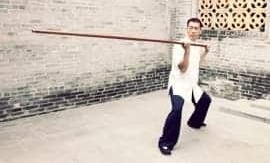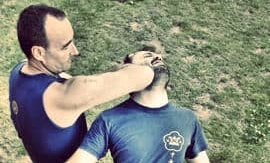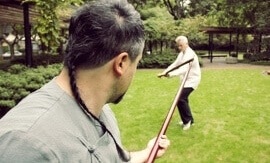
THE TERM “FACE” COULD MEAN VERY DIFFERENT THINGS TO DIFFERENT PEOPLE. “GIVE ME FACE” IS A COMMON TERM. THIS COULD LITERALLY BE A DEMAND FOR RESPECT. OF COURSE, THIS IS A COMPLEX STATEMENT, BUT IT DOES HAVE AN INTERESTING INTERPRETATION FOR TRAINING WING CHUN.
To some, the term, “face”, can refer to the concept of facing, as indicated in the first form. Alternatively, it could mean giving face as a form of respect and not humiliating your opponent or training partner. Furthermore, the term could, quite literally, mean not hitting the face when practising or comparing Wing Chun. It could even be a combination, that is, pay respect by not hitting the face.
Interestingly, there are different perspectives on whether you should focus primarily on hitting to the face in Chi Sau. One school of thought suggests you should not hit the face in training, as this is not only disrespectful but detracts from the true purpose of Chi Sau. Yet, this is in stark contrast to those that believe it is an important part of the training process.
While Chi Sau is not considered a form of fighting, it is, however, considered by many within the Wing Chun community a measure of skill. However, can this really be a true measure of skill if you do not strike to the face?
The objective of this article is to briefly explore the notion of whether you should hit to the face in Chi Sau in order to relate to psychological limitations that may have an effect on how you respond to combat stress in real-world application.
Not striking the face in Chi Sau can make some sense, as it allows the practitioner to focus on specific aspects of their movements and techniques. Chi Sau is a practical exercise that helps develop the key Seed Shapes of Wing Chun: Bong Sau, Taan Sau and Fook Sau. Some believe, if you focus primarily on hitting the head (referred to as “Head Hunting”), then you become more predisposed to striking and not developing these Seed Shapes. Below are the Top Three related reasons to avoid Head Hunting.
Reason #1: You Lose Structure
Not striking the face facilitates the ability to focus on your structure and positional strategies more easily. For many, Wing Chun teaches elbow energy is key to their hand practice, and therefore, the idea of striking the face (or hitting high) is thought to negate the connection between the elbows and shoulders. Depressing your shoulders, thereby, sinks your elbows and generates sufficient energy in your Seed Shapes.
In this view, having the intention to simply hit over the Bong or Taan Sau to the face is negating the purpose of the development of structure and elbow energy. Hence, some schools consider these techniques as unstoppable, and therefore, deemed disrespectful or bad form to employ these tactics.
Considering the human body can only move and rotate its joints in certain directions, limiting strikes to the face can be both practical and counterproductive. In limiting unstoppable techniques, it does not allow you to experience the difference of someone unskilled clinging to your arms. People in the street may also cling to you in order to stop you hitting, they may even reach over your arms in an attempt to hit your face or grab your clothing.
Reason #2: The Chest is harder to Hit
Many consider hitting the chest in Chi Sau harder than aiming for the face because the arms more closely guard the chest. In this view, if you can hit the chest, then you could easily hit the face. Hence, it is unnecessary to purposefully hit to the face of your training partner. Of course, this bodes for a better training experience. It is more friendly, interactive, less threatening, and enjoyable. Essentially, you are training with your friend and training partner. Therefore, you are unlikely to want to hit your friend in the face. There is logic to this notion.
Reason #3: It Allows Emotional and Physical Composure
Disallowing facial strikes reduces stress and improves the quality of training. This develops a clearer mind and may stop a student from hitting/lashing out from a lack of emotional control. In this view, it is important to distinguish whether you are hitting the face because you lashed out, or you followed a specific concept of movement. Accordingly, if hitting the face occurs because of a lack of understanding of the correct path of attack, then the reason for the head strike is incorrect.
Lashing out suggests a lack of emotional control or ability to respond to the pressure of the exercise. Yet, herein lies the problem of Chi Sau. It is essentially a low-intensity exercise that requires a great degree of skill, physical, and emotional control. It does not, however, develop the breaking point of the practitioner’s emotional or physical control or further push these boundaries.
Chi Sau is not fighting! However, it does become a measure of your ability to perform rudimentary concepts of Wing Chun. Chi Sau is a low-intensity training exercise that prepares specific skills, such as sticking and containing. It is, essentially, a cooperative exercise. Therefore, there are physical and emotional boundaries in which the practitioners do not stray. Here lies the problem; the breaking point is unlikely to be tested without strikes to the face.
The Breaking Point: Necessary for testing your Skills
Breaking points are defined as the inability to perform simplistic or fine motor tasks under a high degree of stress. To a certain degree, intensive Chi Sau can test the breaking point of your structure, stick, and your ability to control the line of attack. However, high-intensity training allows you to test your limitations and keep you focused on the key strategies.
Hitting or being hit does change the manner in which we approach training. The action itself leads to stress. Under these circumstances, students often react instinctively by turning away when hit in the face or simply drop their arms when they are tired. In addition, stress often leads to premature exhaustion in which the practitioner becomes fatigued very quickly. Therefore, high-intensity training must include a psychological component that prepares you emotionally for combat.
Developing the Psychology: Pushing the boundaries of the Breaking Point
Of course, you could never simulate the stress of a real combat situation in the Kwoon, but it is possible to push the breaking point of a person’s technique. Yet, this is only possible by developing confidence in coping with stress. This can be achieved in a number of ways.
The first is to raise the level of intensity in a controlled fashion. Many martial arts have a competitive aspect that allows the practitioner to compete against a non-compliant, highly motivated opponent. This, in itself, pushes the breaking point of the practitioners. Training for competition requires a degree of intensity (see WCI Issue No. 25), while the event itself pits you against an unknown non-compliant individual, and this requires replication for Wing Chun training.
It is not suggested that you enter competitions, but embrace the aspect of training for the unknown. One simple exercise that does help is to regularly change your Chi Sau partner every 60 to 90 seconds. Such short durations make it difficult to adjust to a new tempo and range of attacks. Breaking points are tested even further if your partner is fresh on every rotation.
It is not simply the case of hitting the face or training more aggressively. Effective training is smart, while safe. Developing confidence requires that you develop a fighter’s mind. This will involve a partner that is willing to work with you to safely push your boundaries.
On Closing
Striking to the face is a necessary requirement in Chi Sau. Although it can be intimidating, the act alone will develop a fighter’s mind, while testing the breaking point of your structure and ability to cope with stress. Last, there are a number of steps that can help develop confidence. The first is to use the various exercises within Wing Chun as a scaffold towards more high-intensity training. Ultimately, no one can prepare you for the unknown or give you face.



















